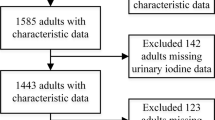Abstract
Urinary iodine (I) and serum and urinary thiocyanates (SCN−) were determined in sample groups from 12 areas of endemic goiter in Italy. The mean urinary I level of 637 subjects with thyroid 0 was 67 ± 31 (mean ± SD) μg/Nter, that of 648 with goiter 54 ± 29 μg/liter. Mean serum and urinary SCN− were 2.44 ± 1.36 mg/liter and 2.58 ± 1.36 mg/liter in 887 and 1531 subjects, respectively. The thiocyanates data enabled a distinction to be drawn between two groups (populations). Population I included 73% of the adults and 92% of the school-children (6–16 yr). Its thiocyanate values were logarithmically spread around means of 1.24 ± 0.6 mg/liter (serum) and 1.24 ± 0.57 mg/liter (urine), whereas those of population II were widely dispersed around means of 6.1 ± 3.0 mg/liter and 8.08 ± 5.5 mg/liter respectively. The boundary between the two populations was set at 3 mg/liter urine SCN−. This distinction was substantiated by the fact that 90% of those in population II smoked 10 or more cigarettes a day, whereas population I comprised occasionally smokers only. It is believed that only the values in population I can be regarded as representative of thiocyanates either endogenous or due to dietary intake: these values never differed more than 60% regardless of the areas, seasons, or dietary habits. As urinary SCN− levels rose, there was also an increase in urinary iodine excretion within certain limits. This, however, did not interfere with thyroid secretion. The urinary l/SCN" ratio was lower in subjects with goiter. This was because their iodine levels were lower, whereas SCN− values were much the same in subjects with and without goiter. We have found no correlation between thiocyanate itself and goiter.
Similar content being viewed by others
References
Grassi B. Sulla etiologia del gozzismo. Tipografia del Senato, Roma, 1914.
Mc Carrison R. The aetiology and epidemiology of endemic goiter. Bericht uber die Internationale Kropfkonferenz in Bern. Hans Huber, Bern, 1927, p. 304.
Hettche O. Etiologie, patogenese et prophylaxie du goitre. In: Ordine Mauriziano (Ed.), Le tireopatie. Cecchini, Torino, 1954, vol. 4, p. 11.
Gaitan E., Wahner H.W. Studies on the pathogenesis of endemic goiter in the Cauca valley, Colombia, South America. In: Stanbury J.B. (Ed.), Endemic goiter. PAHO, Washington, 1969, p. 252.
Langer P., Greer M.A. Antithyroid substances and naturally occurring goitrogens. S. Karger, Basel, 1977.
Ermans A.M., Mbulamoko N.M., Delange F., Ahluwalia R. Role of cassava in the etiology of endemic goiter and cretinism. International Development Research Centre, Ottawa, 1980.
Delange F., Iteke F.B., Ermans A.M. Nutritional factors involved in the goitrogenic action of cassava. International Development Research Centre, Ottawa, 1982.
Reinwein D., Irmscher K. Untersuchung zur Wirkung von rhodanid auf den Jodstoffwechsel der menschilichen Schildruse. Acta Endocrinol. (Kbh.) 49: 629, 1965.
Virion A., Deme D., Pommier J., Nunez J. Opposite effects of thiocyanate on tyrosine iodination and thyroid hormone synthesis. Eur. J. Biochem. 112: 1, 1980.
Wright E. Goitrogens of milk produced on kale. Nature 181: 1602, 1958.
Vanderlaan J.E., Vanderlaan W.P. The iodine concentrating mechanism of the rat thyroid and its inhibition by thiocyanate. Endocrinology 40: 403, 1947.
Ermans A.M., Delange F., Van Der Velden M., Kinthaert J. Possible role of cyanide and thiocyanate in the etiology of endemic cretinism. In: Stanbury J.B., Kroc R.L. (Eds.), Human developmeni and the thyroid gland. Relation to endemic cretinism. Plenum Press, New York, 1972, p. 455.
Virtanen A.I. Final report on investigations on the alleged goitrogenic properties of milk. Biochemical Institute, Helsinki, 1963.
Clements F.W. Naturally occurring goitrogens. Br. Med. Bull. 16: 133, 1960.
Podoba J., Langer P. Naturally occurring goitrogens and thyroid function. Publishing House of the Slovak Academy of Sciences, Bratislava, 1964.
Silink K., Cerny K. Endemic goiter and allied diseases. Publishing House of the Slovak Academy of Sciences, Bratislava, 1966.
Peltola P. The possible role of goitrogens with thiouracil-type effect in the etiology of endemic goiter. In: Podoba J., Langer P. (Eds)., Naturally occurring goitrogens and thyroid function. Publishing House of the Slovak Academy of Sciences, Bratislava, 1964, p. 241.
Horvat A., Krismanic V. The possible role of kale as an etiological factor in endemic goiter on the island of Krk. In: Podoba J., Langer P. (Eds)., Naturally occurring goitrogens and thyroid function. Publishing House of the Slovak Academy of Sciences, Bratislava, 1964, p. 297.
Platzer S., Fill H., Riccabona G., Glatzl J., Seild J., Cenderelli G., Migliardi M., Varetto H., Costa A. Endemic goiter in Alto Adige. Acta Endocrinol. (Kbh.) 85: 325, 1977.
Delange F., Vigneri R., Trimarchi F., Filetti S., Pezzino V., Squatrito S., Bourdoux P., Ermans A.M. Etiological factors of endemic goiter in northeastern Sicily. J. Endocrinol. Invest. 2: 137, 1978.
Dalferes E.R., Webber L.S., Radhakrishnamurthy B., Berenson G.S. Continuous-flow (autoanalyzer) analysis for plasma thiocyanate as an index to tobacco smoking. Clin. Chem. 26: 493, 1980.
Gambino S.R., Schreiber H., Covolo C. An evaluation of autoanalyzer automatic diagnostic procedure for measurement of serum protein bound iodine (P.B.I.) as serum thyroxine iodine (T4). In: Sleggs L.D. (Ed.), Automation in analytical chemistry. Mediad Inc., New York, 1966, p. 363.
Giraudi G., Grillo C. Direct spectrophotometric determination of thiocyanate in serum and urine with a continuous-flow analyzer. Analytical Chim. Acta 128: 169, 1981.
Lundquist P., Martenson J., Sorbo B., Ohman S. Method for determining thiocyanate in serum and urine. Clin. Chem. 25: 678, 1979.
Halmi N.S., King L.T., Winder R.R., Hass A.C., Stuelke R.J. Renal excretion of radioiodine in rats. Clin. J. Physiol. 793: 379, 1958.
Costa A., Cetini G., Cottino G., Ferrara G.C., Ferraris G.M., Fregola G., Marocco F. II ricambio dello iodio nel gozzo endemico. In: Ordine Mauriziano (Ed.), Le tireopatie. Cecchini, Torino, 1957, vol. 7, p. 355.
Author information
Authors and Affiliations
Rights and permissions
About this article
Cite this article
Costa, A., De Filippis, V., Barbeni, M. et al. Thiocyanates and iodine in endemic goiter in Italy. J Endocrinol Invest 7, 103–110 (1984). https://doi.org/10.1007/BF03348398
Received:
Accepted:
Published:
Issue Date:
DOI: https://doi.org/10.1007/BF03348398




